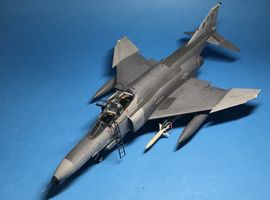Hasegawa 1:48 F-4G Phantom II 69-7233, USAF
 The Story
The Story
First flying in 1975, the F-4G was a converted F-4E Phantom, redesigned with electronic warfare equipment to detect and destroy enemy radars. A key weapon for the F-4G was the AGM-88 HARM anti-radiation missile designed to home in on electronic transmissions from surface-to-air radar systems. On 16 August 1990, 24 F-4Gs of the 561st TFS deployed to Shaikh Isa Air Base in Bahrain. There, the would be part of the 35th TFW(P) which would include Air National Guard RF-4Cs and another F-4G squadron from the 81st TFS at Spangdahlem Air Base, Germany. Later in the conflict, additional aircraft crews arrived from Clark AFB in the Phillipines.
In achieving air-superiority, CENTAF needed to neutralize the French designed and built Iraqi Integrated Air Defense System known as KARI. Wild Weasels flew on the first night of the war as part of Poobah's Party. This in part involved launching drones from Saudi Arabia and airborne aircraft into Iraq, which the Iraqis illuminated with their radars. Behind the drones would be Wild Weasels, and Navy aircraft armed with AGM-88s that targeted the Iraqi radars. When Weasel crews detected an Iraqi radar, they would fire HARM missiles though they would often be unable to confirm the target was destroyed versus the radar turning off. Sometimes, a "kill" would be determined if the radar stopped emitting at expected missile impact time. Whether destroyed or turned off, an inactive Iraqi radar would not be able to harass Coalition planes. Wild Weasels were a high-demand asset during the war, providing SEAD escort to Coalition strike aircraft. As a testament to their success, few Coalition aircraft were shot down due to radar guided weapons. The 561st TFS flew 1,182 combat sorties without loss. Though, the wing did loose one F-4G when the aircraft ran out of fuel while trying to make an emergency landing at King Khalid Military City.
The 561st TFS returned to George AFB in late March.
The Kit
There is plenty of aftermarket available for the 1:48 Phantom, but I wanted to keep this build relatively simple. Some changes I made was to drop the kit ailerons to represent a plane that is parked. Also, the kit lacks the low band antenna found on both sides of the fin. They are molded on the nose, but not the kit fin. I used small plastic styrene pieces to represent the antennas. Otherwise, the model airframe is sufficient for a Desert Storm build.
The aftermarket I did use include:
Black Box F-4G cockpit set
2 AGM-88 HARM missiles from a Hasegawa F-16CJ kit, the two HARM launcher adapters a from a Hasegawa Weapon's set
2 AIM-7M Sparrow missiles from Hasegawa Weapons Set C
a ALQ-167 ECM pod from the Hasegawa Weapons Set E
metal pitot / nose probe from Master Models
Fuselage colors were airbrushed with Tamiya and Gunze Sangyo paints. In the past, I had used Model Master Gunship Gray but that paint was not readily available when working on this model.
For markings, I decided to make a jet from the 561st TFS because of the classic "WW" tail code for wing's Wild Weasel role. Jets from this squadron did not have distinct "Desert Storm" markings like other aircraft; no mission markings or nose art. Therefore, I used decals for various decal sheets to represent F-4G 69-7233. I chose this aircraft specifically because its crew names were erased; making it easier to represent than placing names on the canopy for crew names. The 561st F-4Gs had their unit markings painted over. I made appropriately shaped masks out of acetate sheet to paint the areas where the unit markings would have been located.




